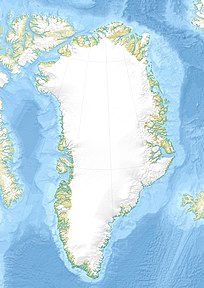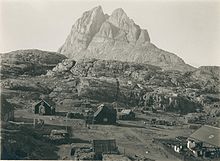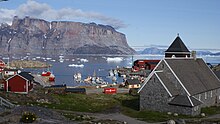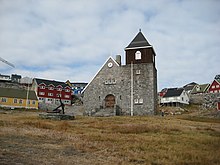Uummannaq
| Uummannaq (the seal heart shaped) | ||
|---|---|---|
| Ũmánaĸ | ||
| Uummannaq (2010) | ||
| Commune | Avannaata Communia | |
| District | Uummannaq | |
| Geographical location | 70 ° 40 ′ 39 ″ N , 52 ° 7 ′ 19 ″ W | |
|
|
||
| Residents | 1,407 (January 1, 2020) |
|
| Post Code | 3961 | |
| founding | 1758/1763 | |
| Time zone | UTC − 3 | |
Uummannaq [ ˈuːˌmːanːɑq ] (according to the old spelling Ũmánaĸ ) is a Greenland city in the district of Uummannaq in the Avannaata Kommunia .
location
Uummannaq is located on the southern tip of an island of the same name in Uummannap Kangerlua . On it is the striking 1175 m high heart-shaped mountain Uummannaq , which gave the island and the place its name. The nearest settlements are Qaarsut 20 km west and Saattut 24 km northeast.
history
Before the colonial era
Archaeological finds show that the area has been inhabited for thousands of years. On the mainland a few kilometers to the south, several 500-year-old mummies were found in Qilakitsoq in 1972 , which are now exhibited in the Greenland National Museum in Nuuk . Before the colonial era, the island was populated on both the east and west coasts.
18th century
On April 7, 1761, the colony founded by Johan Henrik Bruun under the direction of Carl Dalager in Nuussuaq was ordered to move 90 km east to Uummannaq because of the poor location. For this purpose, the house, the provision house and the bacon house were moved from Nuussuaq to Uummannaq in 1763. The house was so small that the assistant had to move in with his Greenlandic wife in 1765 so that the new missionary had room. A school chapel was built around 1775. In 1777 a new provision house was built and the old one converted into a missionary apartment.
In the 1770s, the colony was economically unsuccessful, which was due to the large population to be fed and poor hunting yields. At the beginning of the 1780s, the colony was considered to be abandoned, but the emergence of yarn fishing led to an economic boom, which soon made the colony one of the most important places in North Greenland.
In which it operated despite the arctic climate of the merchant and the missionary in the 1780s, a garden, kale , root vegetables , spinach and watercress grew.
In 1787 there was already a 74 m² apartment building for the merchant and assistant in Uummannaq, a multi-storey building for the team, a provision house and a bacon house, each as a half-timbered building, a cooperage, a brewery, a forge, a coal house and two material houses, all built as peat-walled houses had been. In 1789 a merchant, an assistant, a cooper, a carpenter, two cooks and four workers were employed. At the beginning of the 1790s the first Udsted were laid out and the trade was further expanded. In 1796 the team already consisted of a carpenter, three coopers, two cooks, a blacksmith and six workers. The old provision house, which now served as a missionary apartment, measured only 35 m² and was leaky and very cold and three missionary wives had already fallen ill and died in it. In 1794 the missionary apartment from Upernavik was moved to Uummannaq and replaced the old building that now served as a team house. In 1804 a new bacon house was built.
In 1793, 58 people lived in the colony. In 1798 the population had risen to 70 people. 1805 Uummannaq had 69 inhabitants. Uummannaq is the place of origin of the Greenlandic families Hammond, Leibhardt, Ramsøe and Fleischer.
19th century
During the war from 1807 to 1814, no ship reached the colony for six years. Most of the Udsted had to be abandoned and, as everywhere in Greenland, trade came to a standstill.
In 1835 a 75 m² church was built to replace the 60 year old school chapel. A little later, around 1840, the colony also received a new school. In 1849 there were 127 people in Uummannaq, spread over six to seven houses. From 1892 the former missionary apartment was used as a school before a new school was built around 1920. In 1905, 191 Greenlanders lived in Uummannaq alongside the Danish colonists.
20th century
In 1911 Uummannaq became the capital of a community that still included the Sermiarsuit residential area . There were three men on the town council. The municipality was in the 9th district of North Greenland. Uummannaq was also the seat of a parish and the district's chief catechist also had his seat here. Since 1905 Uummannaq was also the seat of a district doctor.
In 1915 there were 12 Danes and 206 Greenlanders in the colony. The population consisted of 23 employees, 25 hunters and 5 fishermen. The Greenlanders lived in 35 houses at that time. The public buildings in the colony also included the church from 1835, the school used as such since 1892, the pastor's apartment from 1895, the hospital from 1880, the doctor's apartment from 1907, a provision house from 1856, and a store with provisions from 1861 Storage room from 1853, two sheds for coal and barrels from 1886 and 1901, a kerosene house from 1908, a powder house from 1873, a bacon house with a potion factory from 1860, a cooper and carpentry workshop from 1852, a forge from the same year, a bakery from 1848 , a brewery, the colonial administrator's apartment from 1871, the assistant's apartment from 1910 and the team house from 1904.
The area around Uummannaq was the location for the film SOS Iceberg by film pioneer Arnold Fanck from 1932/1933. Leni Riefenstahl , Sepp Rist , Ernst Udet , Gibson Gowland and Walter Riml played the leading roles . At the same time, the North Pole was created - Ahoy! by director Andrew Marton with the assistance of Guzzi Lantschner and Walter Riml; the female lead was occupied by Jarmila Marton . The film is considered a parody of SOS Eisberg and received rave reviews at its premiere, but has been lost to this day despite an intensive global search in various archives.
1950 Uummannaq became the seat of the new municipality Uummannaq , the second largest in Greenland after the municipality Upernavik by the number of associated villages . During the administrative reform in 2009, it was incorporated into Qaasuitsup Kommunia and has been part of Avannaata Kommunia since 2018 .
List of colonial employees until 1921
Colonial administrator
The following people worked as colonial administrators in Uummannaq until 1921.
- 1758–1770: Johan Henrik Bruun
- 1770–1778: Johan Christopher Hammond
- 1778–1780: Nikolaj Daniel Muus
- 1780–1782: Jørgen Arnkiel
- 1782–1787: Nikolaj Daniel Muus
- 1788–1789: Peter Lorentz Bang
- 1789–1790: Johann Friederich Lammerssen
- 1790–1793: Frederik Christian Kragstedt
- 1793-1799: Peter Nicolai Randulff
- 1799–1803: Otte Rosenstand
- 1803-1808: Nicolai Julius Rasmussen
- 1808-1820: Ole Adolf Winding
- 1820–1851: Hans Mossin Fleischer
- 1851–1870: Einar Hansen
- 1870–1880: Eduard Gaspar Boye
- 1880–1891: Anthon Frederik Søren Møldrup
- 1891–1894: Otto Alexander Juncker
- 1894–1899: Hjalmar Christian Reinholdt Knuthsen
- 1899–1900: Louis Victor Mathiesen
- 1900–1902: Johan Carl Joensen
- 1902–1903: Johan Christian Evensen
- 1903–1913: Louis Victor Mathiesen
- 1913–1914: Einar Andersen
- from 1914: Johannes Otto Frederik Mathiesen
Missionaries and pastors
Uummannaq had the following missionaries and pastors until 1921. From 1799 to 1817 Uummannaq was part of the parish of the Jakobshavn colony district , as well as from 1828 to 1831 and 1877 to 1894. The missionary lived there from 1867 to 1876 without Uummannaq being directly subordinate to the Jakobshavn colony. From 1885 to 1895, however, an ordained head catechist below the Jakobshavn colony was entrusted with the ecclesiastical management of the Uummannaq colony.
- 1765–1771: Jonas Gill
- 1771-1777: Peder Rasmussen
- 1777–1783: Christian Gjerløff
- 1783–1792: Peter Andreas von Cappelen
- 1792–1797: Hans Peter Jansen
- 1797–1799: Andreas Ostermann
- 1817–1823: Hans Peter Jansen
- 1823–1828: Hans Peter Johannes Beldring
- 1831–1837: Johan Christian Vilhelm Funch
- 1837-1845: Morten Fabricius Dan Hammer
- 1845: Christian Godske (interim)
- 1845–1846: Morten Fabricius Dan Hammer
- 1846–1855: Bernhard Ludvig Christian Haase
- 1855–1858: Niels Peter Simonsen
- 1858–1867: Christian Ulrich Top Mielche
- 1867–1870: Nikolaj Edinger Balle
- 1870–1872: Osvald Vilhelm Bøggild
- 1875–1876: Christian Vilhelm Rasmussen
- 1876–1877: Christian Vilhelm Rasmussen
- 1885–1889: Erneĸ Jens Lars Johan Berthelsen (head catechist)
- 1890–1895: Hans Andreas Jakob Theophilus Hansen (head catechist)
- 1894–1903: Hans Georg Baadsgaard
- 1903-1907: Rasmus Sørensen
- 1907–1909: Erik Jespersen
- 1909–1911: Rasmus Jørgen Nielsen
- from 1911: Rasmus Sørensen
doctors
Uummannaq was spun off as a medical district from the North Greenland Medical District in 1905.
- from 1905: Alfred Leopold Bertelsen
economy
Before it was officially founded, Uummannaq was a whaling town because the sea here is rich in narwhals and belugas . With the colonization came a concentration on the seal hunt . Today fishing is of the utmost importance in Uummannaq. In addition to black halibut , striped sea wolves , redfish , cod , sea hares and capelin are also fished on a smaller scale and processed in the local fish factory of Royal Greenland . Tourism also plays a larger role in Uummannaq. Dogsled rides and whale watching are offered for tourists. The area is also interesting for hiking and climbing tourists. In addition, the ice golf world championship took place regularly from 1999 at Uummannaq .
Infrastructure and supply
The port of Uummannaq is located in the southeast of the city and consists of two smaller quays with a water depth of about 4.20 m. There are also several moorings for smaller fishing boats on the coast. The sea is navigable from June to December. There is no space for an airport on the small mountainous island, which is why the airport for the region was established in Qaarsut in 1999. From there a helicopter connection leads to the Uummannaq heliport . Most of the developed road network in Uummannaq is paved.
Nukissiorfiit supplies the place with electricity via a power station and with drinking water via water pipes from the two lakes Tasersuaq and Tasersuaq Qulleq . Oil stoves ensure the heat supply. The garbage is dumped and incinerated in the north of the city and the sewage is discharged into the sea. TELE Greenland is responsible for telecommunications in town.
Development
Uummannaq has a kindergarten with a crèche and a children's home. The children's home run by the Faroese Ann Andreasen is very well known and, among other things, a central component of the feature film Inuk . Numerous reports have already been made about this in Germany. The Edvard Krusep Atuarfia teaches about 250 students up to the tenth grade and also houses the library and a youth club. Uummannaq has a branch of the Piareersarfik vocational center and is the seat of the Piniarnermut Aalisarnermullu Ilinniarfik , the Greenlandic hunting and fishing school. For the elderly there is the Utoqqaat Illuat nursing home . In the city there is also a hospital and a dental practice, a municipal office, a police station, a fire station, several pubs, cafes or bars, three shops, including a Pilersuisoq branch. Uummannaq's historic city center with buildings from the colonial times is worthy of preservation. There are a total of 28 buildings worth preserving in the city. In addition, in 1935 by Danish architect is Helge Bojsen-Møller built stone church of granite protected as a landmark of the city and largest stone church in the country as a historic landmark.
Sons and daughters
- Tobias Mørch (1840–1916), catechist and pastor
- Johan Henningsen (1876–1952), Provincial Councilor
- Pavia Pollas (1885–?), National Councilor
- Nikolaj Hansen (1892–?), Provincial Councilor
- Elisabeth Johansen (1907–1993), State Councilor
- Kristian Johansen (1915–1958), National Councilor
- Hans Johansen (1928–?), Judge and regional councilor
- Frederik Kristensen (* 1952), painter, sculptor, musician and poet
- Juaaka Lyberth (* 1952), musician and writer
- Anne-Lise Løvstrøm (* 1960), artist and teacher
- Karl Frederik Danielsen (* 1971), politician (Siumut) and teacher
Population development
The population of Uummannaq increased to around 1500 in the 1990s and has been falling again since then. It was not until the summer of 2017 that the population skyrocketed when the city had to take in most of the residents of the Nuugaatsiaq and Illorsuit settlements that were destroyed and evacuated by the tsunami in the Karrat Fjord .

Web links
Individual evidence
- ↑ Map with all official place names confirmed by Oqaasileriffik , provided by Asiaq
- ↑ a b c Uummannaq at qaasuitsup-kp.cowi.webhouse.dk
- ↑ a b c Uummannaq at groenlandkreuzfahrt.de
- ↑ a b c d e f g h i j k Alfred Bertelsen , Hother Ostermann : Beskrivelse af Distrikterne i Nordgrønland: Ũmánaĸ District. De grandson Bopladser. Ũmánaĸ . In: Georg Carl Amdrup , Louis Bobé , Adolf Severin Jensen , Hans Peder Steensby (eds.): Grønland i tohundredeaaret for Hans Egedes landing (= Meddelelser om Grønland . Volume 60-61 ). tape 1 . C. A. Reitzel Boghandel, Copenhagen 1921, p. 382 ff . ( Digitized in the Internet Archive ).
- ↑ 250 år - og stadig må mærkerne in the Avannaani tamanut of July 17, 2013
- ↑ North Pole Ahoy! in the Internet Movie Database (English)
- ↑ a b Uummannaq in Den Store Danske
- ^ A b c Hother Ostermann : Beskrivelse af Distrikterne i Nordgrønland: Ũmánaĸ district. History . In: Georg Carl Amdrup , Louis Bobé , Adolf Severin Jensen , Hans Peder Steensby (eds.): Grønland i tohundredeaaret for Hans Egedes landing (= Meddelelser om Grønland . Volume 60-61 ). tape 1 . C. A. Reitzel Boghandel, Copenhagen 1921, p. 381 f . ( Digitized in the Internet Archive ).
- ↑ Population Uummannaq 1977-2020 at bank.stat.gl






